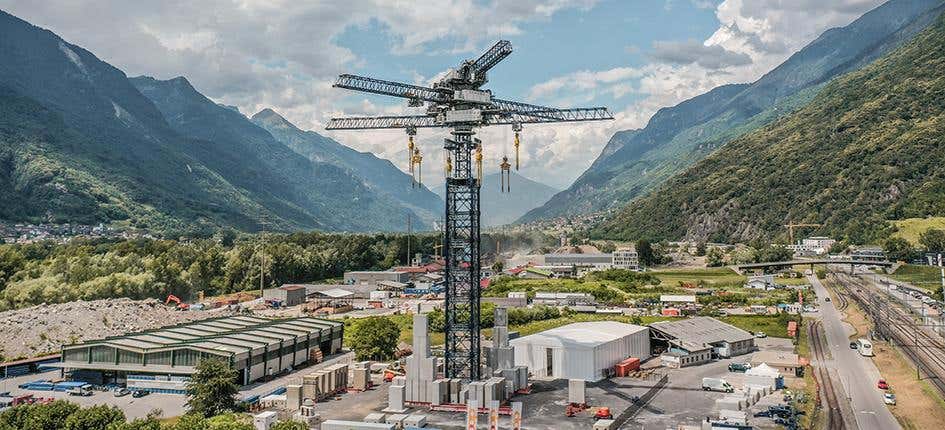Gravity can solve clean energy’s biggest tech problem
The system hoists 30 tonne “mobile masses” into the air using excess energy. When the need arises for the power, the mass descends.

[Mar 14, 2022: Joseph Shavit, The Brighter Side of News]
Energy Vault has developed a technology for storing energy by gravity. (CREDIT: Energy Vault)
Renewables cannot provide consistent power without high-efficiency and high-availability storage. Unlike a fossil fuel power station, which can operate night and day, wind and solar power are intermittent. This means that if a cloud blocks the sun or there's a lull in the wind, electricity generation drops.
The advanced gravity energy storage solutions offered by Energy Vault address this problem through proven physics and engineering fundamentals of pumped hydroelectric energy storage. However, they replace water with custom-made composite blocks, known as "mobile masses", that do not lose capacity over time. By using proprietary technology, the system can automatically raise and lower the bricks, storing the potential energy in the elevation gain, and then generating and discharging electricity while the bricks are lowered.
In this system, excess energy is used to hoist 30 ton "mobile masses" into the air. When power is required, the mass descends which is similar to pumped hydroelectric storage.
The composite blocks can be made from low-cost and locally sourced materials, including the excavated soil at the construction site, but can also utilize waste materials such as mine tailings, coal combustion residuals (coal ash), and fiberglass from decommissioned wind turbine blades.
Energy Vault - Commercial Demonstration Unit (CREDIT: Business Wire)
Additionally, the Energy Vault systems are intended to minimize environmental and supply chain risks. The systems are automated with advanced computer control and machine vision software that orchestrate the charging and discharging cycles while meeting a broad set of storage durations starting from 2 hours and continuing to 12 hours, or more.
Related Stories:
Crunching numbers
The company’s vice president of sales Omar Aoun, speaking to Energy Voice in Abu Dhabi last month, said the technology had a round trip efficiency of around 80%.
Visual representation of how Energy Vault technology stores and releases energy by gravity. (CREDIT: Energy Vault)
“It’s second best to batteries, which offer around 90% for four hours of storage. Alternative storage options are around 60% or less,” he said. “It’s very scalable. The way to think of it is that width is what drives the MW and the depth of the building is what drives the MWh.”
To be cost effective, an Energy Vault project would need a minimum size of 25 MW with a duration of eight hours, he said. The company calculates that a two acre plot would provide 100 MW, with a height of 100 metres, so 1 GW would require 20 acres.
Energy Vault has a demonstration project in Switzerland in operation, which it connected to the grid in July 2020. This plant is helping the company tackle efficiency while also driving costs down. This original design was similar to a crane, while the newer design, EVx, is more like a building.
“At scale, this becomes more economical than batteries. The foundation is a big part of the cost,” Aoun said. The company claims that its technology is 51% of the cost of lithium ion batteries.
“There’s a mix of customers, from independent power producers [IPPs], large utilities and through to large mining companies.” The company has signed a memorandum of understanding (MoU) with BHP.
Power from an energy storage project can go to a variety of uses, whether simply providing electricity, or green hydrogen or pricing arbitrage.
On track for Texas
“The first commercial project will start up by the end of next year and it will be in Texas,” Aoun said. “Energy storage is a growing market and it will continue to grow. We’re only scratching the surface at this point.”
One area for growth will be in China. Atlas Renewable, backed by China Tianying, made a $50m investment in Energy Vault before the listing. It will pay another $50m to licence the energy storage technology this year.
In building the mobile masses, Energy Vault has raised the prospect of using combustion residuals from coal power plants and repurposing materials from wind turbine blades. Enel Green Power has signed up to back the latter.
For more science news stories check out our New Innovations section at The Brighter Side of News.
Note: Materials provided above by The Brighter Side of News. Content may be edited for style and length.
Like these kind of feel good stories? Get the Brighter Side of News' newsletter.
Tags: #New_Innovation, #Green_Innovations, #Batteries, #Energy_Efficiency, #Technology, #Clean_Energy, #Gravity, #Hydropower, #The_Brighter_Side_of_News
Joseph Shavit
Head Science News Writer | Communicating Innovation & Discovery
Based in Los Angeles, Joseph Shavit is an accomplished science journalist, head science news writer and co-founder at The Brighter Side of News, where he translates cutting-edge discoveries into compelling stories for a broad audience. With a strong background spanning science, business, product management, media leadership, and entrepreneurship, Joseph brings a unique perspective to science communication. His expertise allows him to uncover the intersection of technological advancements and market potential, shedding light on how groundbreaking research evolves into transformative products and industries.



